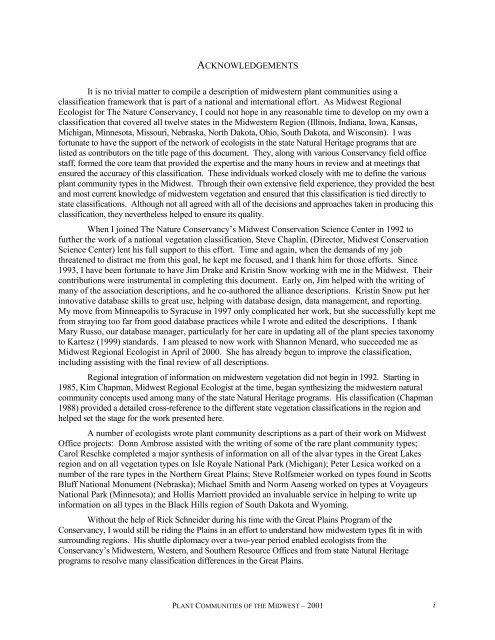Plant Communities of the Midwest - NatureServe
Plant Communities of the Midwest - NatureServe
Plant Communities of the Midwest - NatureServe
Create successful ePaper yourself
Turn your PDF publications into a flip-book with our unique Google optimized e-Paper software.
ACKNOWLEDGEMENTS<br />
It is no trivial matter to compile a description <strong>of</strong> midwestern plant communities using a<br />
classification framework that is part <strong>of</strong> a national and international effort. As <strong>Midwest</strong> Regional<br />
Ecologist for The Nature Conservancy, I could not hope in any reasonable time to develop on my own a<br />
classification that covered all twelve states in <strong>the</strong> <strong>Midwest</strong>ern Region (Illinois, Indiana, Iowa, Kansas,<br />
Michigan, Minnesota, Missouri, Nebraska, North Dakota, Ohio, South Dakota, and Wisconsin). I was<br />
fortunate to have <strong>the</strong> support <strong>of</strong> <strong>the</strong> network <strong>of</strong> ecologists in <strong>the</strong> state Natural Heritage programs that are<br />
listed as contributors on <strong>the</strong> title page <strong>of</strong> this document. They, along with various Conservancy field <strong>of</strong>fice<br />
staff, formed <strong>the</strong> core team that provided <strong>the</strong> expertise and <strong>the</strong> many hours in review and at meetings that<br />
ensured <strong>the</strong> accuracy <strong>of</strong> this classification. These individuals worked closely with me to define <strong>the</strong> various<br />
plant community types in <strong>the</strong> <strong>Midwest</strong>. Through <strong>the</strong>ir own extensive field experience, <strong>the</strong>y provided <strong>the</strong> best<br />
and most current knowledge <strong>of</strong> midwestern vegetation and ensured that this classification is tied directly to<br />
state classifications. Although not all agreed with all <strong>of</strong> <strong>the</strong> decisions and approaches taken in producing this<br />
classification, <strong>the</strong>y never<strong>the</strong>less helped to ensure its quality.<br />
When I joined The Nature Conservancy’s <strong>Midwest</strong> Conservation Science Center in 1992 to<br />
fur<strong>the</strong>r <strong>the</strong> work <strong>of</strong> a national vegetation classification, Steve Chaplin, (Director, <strong>Midwest</strong> Conservation<br />
Science Center) lent his full support to this effort. Time and again, when <strong>the</strong> demands <strong>of</strong> my job<br />
threatened to distract me from this goal, he kept me focused, and I thank him for those efforts. Since<br />
1993, I have been fortunate to have Jim Drake and Kristin Snow working with me in <strong>the</strong> <strong>Midwest</strong>. Their<br />
contributions were instrumental in completing this document. Early on, Jim helped with <strong>the</strong> writing <strong>of</strong><br />
many <strong>of</strong> <strong>the</strong> association descriptions, and he co-authored <strong>the</strong> alliance descriptions. Kristin Snow put her<br />
innovative database skills to great use, helping with database design, data management, and reporting.<br />
My move from Minneapolis to Syracuse in 1997 only complicated her work, but she successfully kept me<br />
from straying too far from good database practices while I wrote and edited <strong>the</strong> descriptions. I thank<br />
Mary Russo, our database manager, particularly for her care in updating all <strong>of</strong> <strong>the</strong> plant species taxonomy<br />
to Kartesz (1999) standards. I am pleased to now work with Shannon Menard, who succeeded me as<br />
<strong>Midwest</strong> Regional Ecologist in April <strong>of</strong> 2000. She has already begun to improve <strong>the</strong> classification,<br />
including assisting with <strong>the</strong> final review <strong>of</strong> all descriptions.<br />
Regional integration <strong>of</strong> information on midwestern vegetation did not begin in 1992. Starting in<br />
1985, Kim Chapman, <strong>Midwest</strong> Regional Ecologist at <strong>the</strong> time, began syn<strong>the</strong>sizing <strong>the</strong> midwestern natural<br />
community concepts used among many <strong>of</strong> <strong>the</strong> state Natural Heritage programs. His classification (Chapman<br />
1988) provided a detailed cross-reference to <strong>the</strong> different state vegetation classifications in <strong>the</strong> region and<br />
helped set <strong>the</strong> stage for <strong>the</strong> work presented here.<br />
A number <strong>of</strong> ecologists wrote plant community descriptions as a part <strong>of</strong> <strong>the</strong>ir work on <strong>Midwest</strong><br />
Office projects: Donn Ambrose assisted with <strong>the</strong> writing <strong>of</strong> some <strong>of</strong> <strong>the</strong> rare plant community types;<br />
Carol Reschke completed a major syn<strong>the</strong>sis <strong>of</strong> information on all <strong>of</strong> <strong>the</strong> alvar types in <strong>the</strong> Great Lakes<br />
region and on all vegetation types on Isle Royale National Park (Michigan); Peter Lesica worked on a<br />
number <strong>of</strong> <strong>the</strong> rare types in <strong>the</strong> Nor<strong>the</strong>rn Great Plains; Steve Rolfsmeier worked on types found in Scotts<br />
Bluff National Monument (Nebraska); Michael Smith and Norm Aaseng worked on types at Voyageurs<br />
National Park (Minnesota); and Hollis Marriott provided an invaluable service in helping to write up<br />
information on all types in <strong>the</strong> Black Hills region <strong>of</strong> South Dakota and Wyoming.<br />
Without <strong>the</strong> help <strong>of</strong> Rick Schneider during his time with <strong>the</strong> Great Plains Program <strong>of</strong> <strong>the</strong><br />
Conservancy, I would still be riding <strong>the</strong> Plains in an effort to understand how midwestern types fit in with<br />
surrounding regions. His shuttle diplomacy over a two-year period enabled ecologists from <strong>the</strong><br />
Conservancy’s <strong>Midwest</strong>ern, Western, and Sou<strong>the</strong>rn Resource Offices and from state Natural Heritage<br />
programs to resolve many classification differences in <strong>the</strong> Great Plains.<br />
PLANT COMMUNITIES OF THE MIDWEST – 2001<br />
i
















